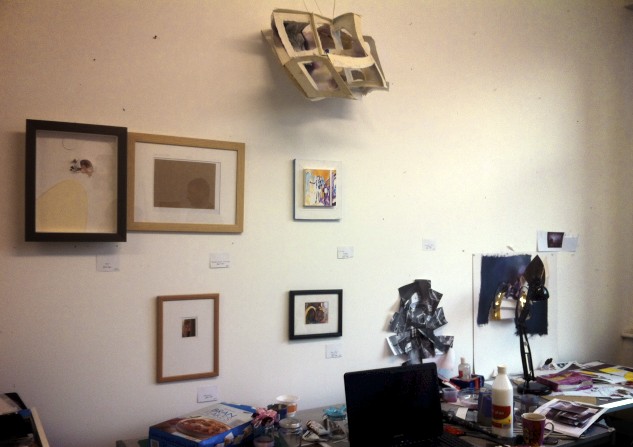Interview: Julia Tryon

THB recently did a studio visit and interview with Newcastle-based artist, JULIA TRYON and talked about her upcoming site-specific installation at Open Shop’s Stairwell Gallery, opening this Friday, January 12, at 6pm.
Julia Tryon’s work often blurs the distinction between photography, sculpture and painting, through the deconstruction and reconstruction of photographs of the natural world, and of fabricated models she creates in her studio. She investigates the human experience of architectural spaces and explores the interplay between two and three dimensions as well as the real versus the imaginary.
Finding an affinity for painting during her years as a fine art student at Newcastle University (where she earned her degree in 2008), she was encouraged to experiment in sculpture and installation, which led her to the work she does today. Tryon’s installation at Empty Shop shows the traces and fragments of an old Hebridean house encountered on a walk on the Isle of Benbecula.
Where do you find the connection between different mediums you work in? Did your work start with one particular medium and then develop into a synthesis of the three?
It’s quite interesting; I suppose it starts with perspective. In a perspective drawing shows different sizes shapes depending on point of view and how close they are to you. I’m interested in trying to translate that into sculpture, because it distorts images. The two-dimensional [photograph] is a sort of a window into a world, imaginary or ideal, but when you start making it into a sculpture it’s sort of becoming a real space.
Can you elaborate on imaginary worlds and your interest architectural spaces?
I’m interested in the feelings that different sorts of spaces create. I recently read a book by Gaston Bachelard, The Poetics of Space, where he talks about different associations with houses, different areas, the corner of a room, or an attic space, and the feelings and memories that they evoke. I guess I try to play around with that in my art, to highlight the feeling of different spaces.
What will viewers see at the Empty Shop?
The work started off from seeing this ruined house in the Hebrides, in Scotland. I was inspired by the bright colored paint and how it’s dilapidated, how a house represents a person’s life, good and bad, and how it’s gradually sort of fading. There are quite inspiring spaces in it. I cut out the photographs and reconstructed them to recreate the spaces. They vary in size from 10cm to about a meter big. I find it interesting how small objects evoke your imagination. There’s something kind of precious about them. It’s interesting when something is really big, it’s creating a space in itself. [The pieces] get bigger as you go through the space. I try to bring a lot of different characteristics in each of them.
Are your sculptures more imaginative or representational?
I mainly do it from the photograph along the logical sort of lines in quite a systematic way of splitting it up. When I first started making them I tried to manipulate it a lot, but that can make it look it a bit false, whereas when you do it along the logical lines then it naturally forms interesting shapes. It’s interesting how [the sculptures] start to take on organic forms. The house is often seen as being stable, rigid and secure, quite a contrast to making it organic, free and changing. It’s kind of like the hand of God at work, deconstructing and reconstructing. I actually read a verse, it’s in Amos (6:11), where it says, “God will smash the large house into pieces, the small house into bits.”
That’s really interesting.
I had actually been praying about how God might be in my work, just before I read it. I don’t actually smash or crush things, I cut them really slowly. But God kind of reconstructs things, opens up our securities, and recreates them into something more beautiful.
You take stairs off the ground of the house and put them near ceiling. It creates a fantastical space in the gallery.
I like the idea of seeing the gallery space and the space of this house, as a sort of colliding of parallel worlds, not quite on the same level.
What do you hope to evoke in the viewer and is it similar or different to what you experienced in the house?
It starts off with being very curious and wanting to explore it. I always like to convey a sense of hope… It’s sort of just about life, also metaphors for life, where there’s always a bit of struggle, things changing and breaking apart, but being beautiful, and putting faith in something good. [In the Hebridean house] you see lots of traces of the people who lived there. It looked like it was once a quite cared for and happy place, but it’s quite strange walking through it and [imagining] it being inhabited. I suppose it’s like with the work, it’s trying to recreate the space and you’re still only seeing something that’s in the past, just kind of the traces of it.
by Josh Tengan
Save the Date:
JULIA TRYON: THE SCALED HOUSE
Stairwell Gallery, Empty Shop HQ, Durham
Preview: Friday, January 20, 2012 at 6pm